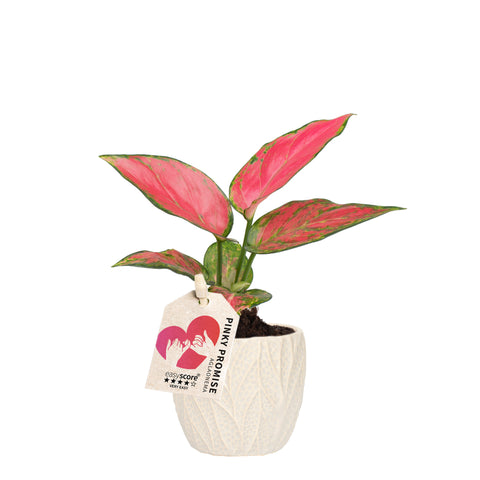Aglaonema ‘Pinky Promise’

Aglaonema 'Pinky Promise'

Botanical name: Aglaonema anyamanee
Common Name(s): Aglaonema ‘Pinky
Promise’, Chinese Evergreens
Aglaonema ‘Pinky Promise’
The Aglaonema ‘Pinky
Promise’ is a colourful plant perfect for anyone seeking to add a dash of
colour to their home. With a slow and graceful growth, this plant offers a
year-round burst of romance, showcasing pale pink foliage in its youth and
deepening to a mesmerizing pink red as it matures.
Also known as Chinese
evergreens, Aglaonemas are often associated with the ancient Chinese
practice Feng Shui, bringing their owners well-being and positive energy.
Consider gifting an ‘Pinky Promise’ to a special someone as a thoughtful
gesture and a promise of everlasting love.
Fun fact: The genus name ‘aglaonema’ is derived from the
Greek words for ‘bright’ and ‘thread’, reflecting the plants’ vibrant and
intricate leaf patterns.
Aglaonema ‘Pinky Promise’ Care Guide
Don’t be afraid to let yourself fall in love with our Pinky Promise!
Compared to other colorful and delicate plants, Pinky Promise plants are relatively
easy to take care of. Give your plant a little love and care and surely your
plant will love you back.
Light and Placement: Aglaonema
Pinky Promise thrives best when placed in bright, indirect light. While it can
tolerate partial shade, this may affect the plant’s coloration and vividness.
Watering: Pinky Promise plants
prefer to stay moist, but not soaking wet.
The best way to know if your plant needs watering is to check the top
2,5 cm of the soil with your finger. If the soil is dry to the touch, it’s time
to water, otherwise wait for a couple of days. If possible, use water that is
room temperature, as cold water can shock the plant.
Read our full guide to watering your plants here.
Temperature: Pinky
Promise plants thrive the best in temperatures between 18° - 28°
Fertilization: A newly purchased plant is already fertilized and will do just fine for
the first 3-5 months. After that, fertilize your plant once a month
during its
growth season, from April to August. Do not
fertilize your plant during winter, as it needs a break during the colder months.
The amount of fertilizer depends on the type you use. It's advisable to err on the lower end of the recommended dosage to avoid over-fertilizing your plant.
